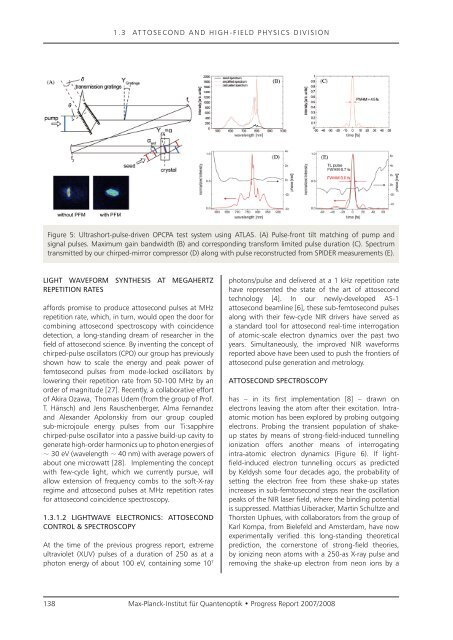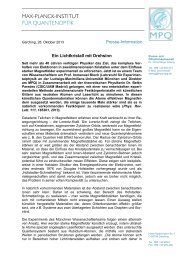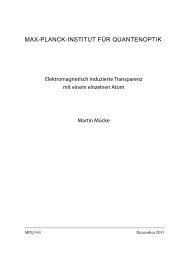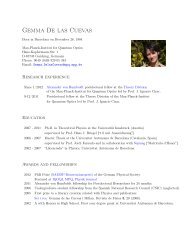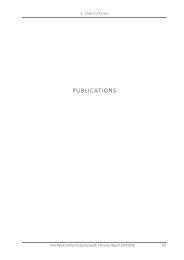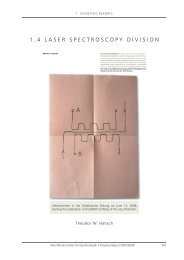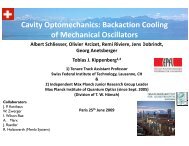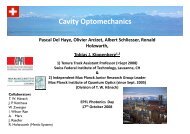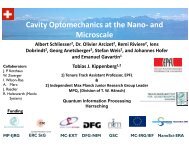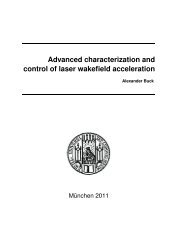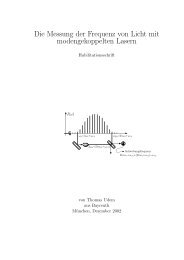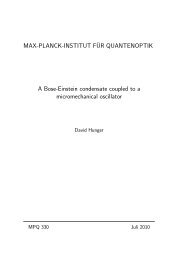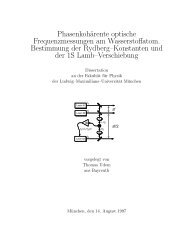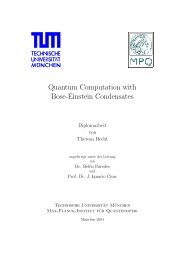Attosecond Control and Measurement: Lightwave Electronics
Attosecond Control and Measurement: Lightwave Electronics
Attosecond Control and Measurement: Lightwave Electronics
Create successful ePaper yourself
Turn your PDF publications into a flip-book with our unique Google optimized e-Paper software.
1 . 3 AT T O S E C O N D A N D H I G H - F I E L D P H Y S I C S D I V I S I O N<br />
Figure 5: Ultrashort-pulse-driven OPCPA test system using ATLAS. (A) Pulse-front tilt matching of pump <strong>and</strong><br />
signal pulses. Maximum gain b<strong>and</strong>width (B) <strong>and</strong> corresponding transform limited pulse duration (C). Spectrum<br />
transmitted by our chirped-mirror compressor (D) along with pulse reconstructed from SPIDER measurements (E).<br />
lIGhT WAVEFORM SYNThESIS AT MEGAhERTZ<br />
REPETITION RATES<br />
affords promise to produce attosecond pulses at MHz<br />
repetition rate, which, in turn, would open the door for<br />
combining attosecond spectroscopy with coincidence<br />
detection, a long-st<strong>and</strong>ing dream of researcher in the<br />
field of attosecond science. By inventing the concept of<br />
chirped-pulse oscillators (CPO) our group has previously<br />
shown how to scale the energy <strong>and</strong> peak power of<br />
femtosecond pulses from mode-locked oscillators by<br />
lowering their repetition rate from 50-100 MHz by an<br />
order of magnitude [27]. Recently, a collaborative effort<br />
of Akira Ozawa, Thomas Udem (from the group of Prof.<br />
T. Hänsch) <strong>and</strong> Jens Rauschenberger, Alma Fern<strong>and</strong>ez<br />
<strong>and</strong> Alex<strong>and</strong>er Apolonskiy from our group coupled<br />
sub-microjoule energy pulses from our Ti:sapphire<br />
chirped-pulse oscillator into a passive build-up cavity to<br />
generate high-order harmonics up to photon energies of<br />
~ 30 eV (wavelength ~ 40 nm) with average powers of<br />
about one microwatt [28]. Implementing the concept<br />
with few-cycle light, which we currently pursue, will<br />
allow extension of frequency combs to the soft-X-ray<br />
regime <strong>and</strong> attosecond pulses at MHz repetition rates<br />
for attosecond coincidence spectroscopy.<br />
1.3.1.2 lIGhTWAVE ElECTRONICS: ATTOSECOND<br />
CONTROl & SPECTROSCOPY<br />
At the time of the previous progress report, extreme<br />
ultraviolet (XUV) pulses of a duration of 250 as at a<br />
photon energy of about 100 eV, containing some 10 7<br />
photons/pulse <strong>and</strong> delivered at a 1 kHz repetition rate<br />
have represented the state of the art of attosecond<br />
technology [4]. In our newly-developed AS-1<br />
attosecond beamline [6], these sub-femtosecond pulses<br />
along with their few-cycle NIR drivers have served as<br />
a st<strong>and</strong>ard tool for attosecond real-time interrogation<br />
of atomic-scale electron dynamics over the past two<br />
years. Simultaneously, the improved NIR waveforms<br />
reported above have been used to push the frontiers of<br />
attosecond pulse generation <strong>and</strong> metrology.<br />
ATTOSECOND SPECTROSCOPY<br />
has – in its first implementation [8] – drawn on<br />
electrons leaving the atom after their excitation. Intraatomic<br />
motion has been explored by probing outgoing<br />
electrons. Probing the transient population of shakeup<br />
states by means of strong-field-induced tunnelling<br />
ionization offers another means of interrogating<br />
intra-atomic electron dynamics (Figure 6). If lightfield-induced<br />
electron tunnelling occurs as predicted<br />
by Keldysh some four decades ago, the probability of<br />
setting the electron free from these shake-up states<br />
increases in sub-femtosecond steps near the oscillation<br />
peaks of the NIR laser field, where the binding potential<br />
is suppressed. Matthias Uiberacker, Martin Schultze <strong>and</strong><br />
Thorsten Uphues, with collaborators from the group of<br />
Karl Kompa, from Bielefeld <strong>and</strong> Amsterdam, have now<br />
experimentally verified this long-st<strong>and</strong>ing theoretical<br />
prediction, the cornerstone of strong-field theories,<br />
by ionizing neon atoms with a 250-as X-ray pulse <strong>and</strong><br />
removing the shake-up electron from neon ions by a<br />
138 Max-Planck-Institut für Quantenoptik • Progress Report 2007/2008


